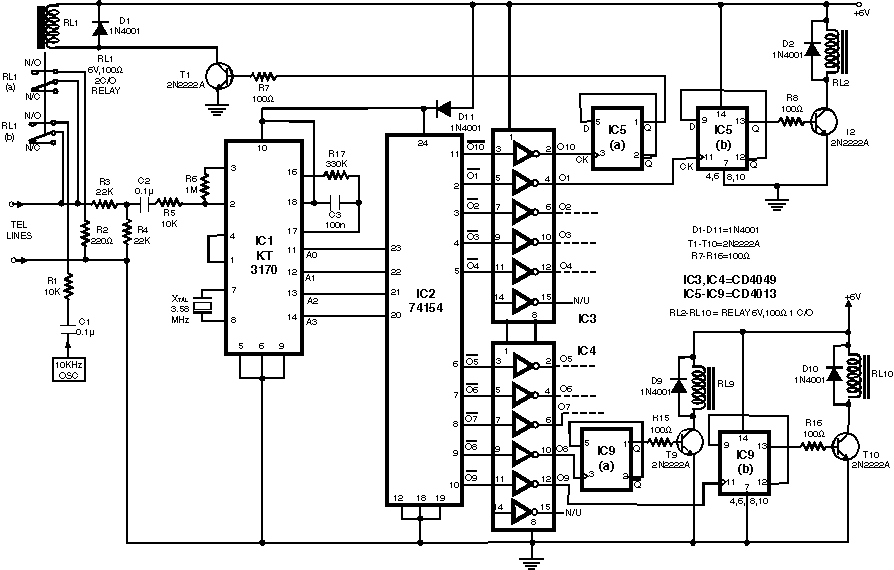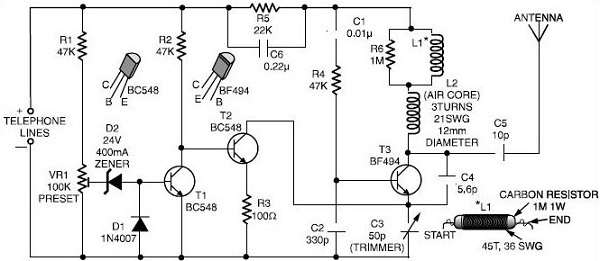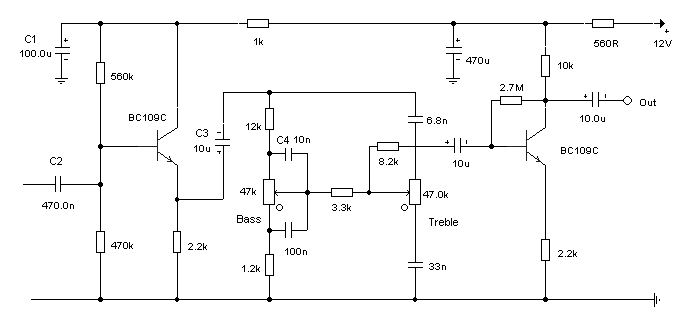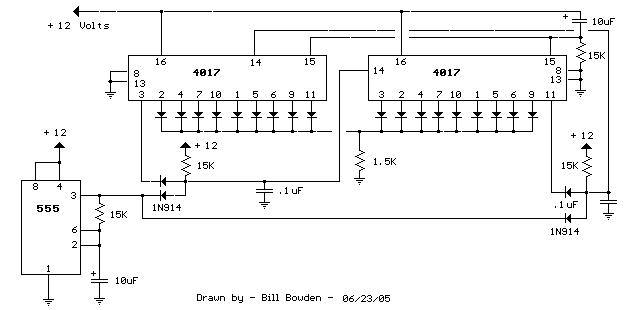
One Of Nine Sequencer
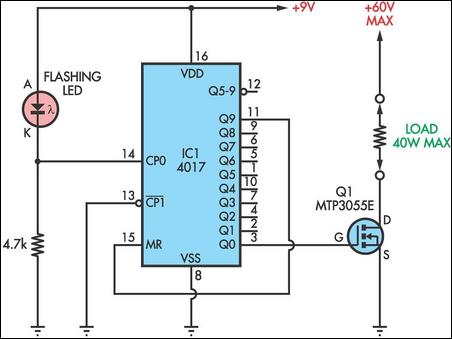
This circuit utilizes a flashing LED as the clock input for a 4017 decade counter. Typical flashing LEDs, such as the DSE cat Z-4044, flash at approximately 2Hz, causing the outputs Q0-Q9 to cycle at that rate. For instance, Q0 will activate for half a second, followed by Q1, Q2, and so forth, up to Q8, before returning to Q0. A maximum of nine outputs can be utilized. To reduce the number of outputs, an earlier output can be connected to the Master Reset (MR) pin 15. If MR is not in use, it should be connected to 0V. Potential applications for this circuit include sequencing various strings of Christmas lights. The resistor from CP0 to ground can range from about 330Ω to 10kΩ; lower resistor values will result in a brighter LED flash if desired. With a 4.7kΩ resistor as indicated, the clock input CP0 (pin 14) will alternate between approximately 2V and 7V. To drive loads of up to 40W at voltages up to 60V, each output should be connected to the gate of a 2N3055E or equivalent MOSFET (such as MTP3055E), as illustrated for Q0.
The circuit design employs a 4017 decade counter, which is a CMOS integrated circuit capable of counting from 0 to 10, activating a corresponding output for each count. The clock input (CP0) is driven by a flashing LED, which serves as a simple yet effective timer. The frequency of the flashing LED determines the counting speed of the 4017, making it suitable for applications that require timed sequences.
Each output pin (Q0 to Q9) of the 4017 can be used to control various loads, such as lights or other electronic devices. The outputs are capable of sourcing a significant current, allowing for direct control of high-power devices. However, due to the limitations of the 4017 output current, the circuit incorporates a power transistor (such as the 2N3055E) to handle higher loads. The transistor acts as a switch, enabling the 4017 to control devices that require more power than the IC can provide directly.
The choice of resistor values between CP0 and ground is crucial for adjusting the brightness of the LED and, consequently, the clock frequency. A lower resistance will increase the current through the LED, resulting in a brighter flash and a more pronounced clock signal. Conversely, a higher resistance will dim the LED and decrease the clock frequency, thus slowing down the counting sequence.
In applications such as Christmas light sequencing, this circuit can create captivating light displays by illuminating different strings of lights in a controlled manner. By connecting the outputs to different light strings and adjusting the MR pin, the sequence can be tailored to the user's preferences. Overall, this circuit exemplifies a practical and versatile approach to using a decade counter for timed output control in various electronic applications.This novel circuit uses a flashing LED as the clock input for a 4017 decade counter. Typical flashing LEDs (eg, DSE cat Z-4044) flash at about 2Hz so the outputs Q0-Q9 will cycle through at that rate. For example, Q0 will turn on for half a second, then Q1, then Q2 etc up to Q8 then it will start at Q0 again.
Up to nine outputs can be used. If you want fewer outputs, connect an earlier output to MR, pin 15. If MR is not used, connect it to 0V. Uses for the circuit include sequencing different strings of Christmas lights etc. The resistor from CP0 to ground can be anywhere from about 330O to about 10kO. Lower values will cause the LED to flash more brightly if that is required. With a 4. 7kO resistor as shown, the clock input CP0 (pin 14) will alternate between about 2V and 7V. To drive loads of up to 40W at up to 60V, connect each output to the gate of a 2N3055E or equivalent Mosfet (MTP3055E etc), as shown for Q0. 🔗 External reference
The circuit design employs a 4017 decade counter, which is a CMOS integrated circuit capable of counting from 0 to 10, activating a corresponding output for each count. The clock input (CP0) is driven by a flashing LED, which serves as a simple yet effective timer. The frequency of the flashing LED determines the counting speed of the 4017, making it suitable for applications that require timed sequences.
Each output pin (Q0 to Q9) of the 4017 can be used to control various loads, such as lights or other electronic devices. The outputs are capable of sourcing a significant current, allowing for direct control of high-power devices. However, due to the limitations of the 4017 output current, the circuit incorporates a power transistor (such as the 2N3055E) to handle higher loads. The transistor acts as a switch, enabling the 4017 to control devices that require more power than the IC can provide directly.
The choice of resistor values between CP0 and ground is crucial for adjusting the brightness of the LED and, consequently, the clock frequency. A lower resistance will increase the current through the LED, resulting in a brighter flash and a more pronounced clock signal. Conversely, a higher resistance will dim the LED and decrease the clock frequency, thus slowing down the counting sequence.
In applications such as Christmas light sequencing, this circuit can create captivating light displays by illuminating different strings of lights in a controlled manner. By connecting the outputs to different light strings and adjusting the MR pin, the sequence can be tailored to the user's preferences. Overall, this circuit exemplifies a practical and versatile approach to using a decade counter for timed output control in various electronic applications.This novel circuit uses a flashing LED as the clock input for a 4017 decade counter. Typical flashing LEDs (eg, DSE cat Z-4044) flash at about 2Hz so the outputs Q0-Q9 will cycle through at that rate. For example, Q0 will turn on for half a second, then Q1, then Q2 etc up to Q8 then it will start at Q0 again.
Up to nine outputs can be used. If you want fewer outputs, connect an earlier output to MR, pin 15. If MR is not used, connect it to 0V. Uses for the circuit include sequencing different strings of Christmas lights etc. The resistor from CP0 to ground can be anywhere from about 330O to about 10kO. Lower values will cause the LED to flash more brightly if that is required. With a 4. 7kO resistor as shown, the clock input CP0 (pin 14) will alternate between about 2V and 7V. To drive loads of up to 40W at up to 60V, connect each output to the gate of a 2N3055E or equivalent Mosfet (MTP3055E etc), as shown for Q0. 🔗 External reference


